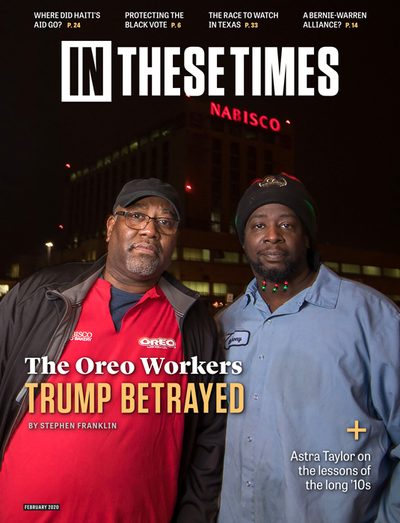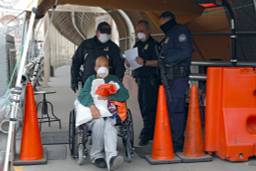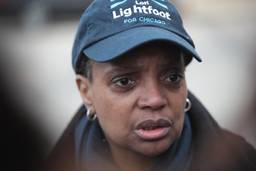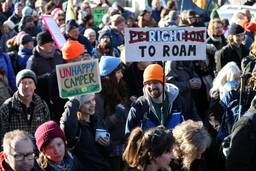Migrant Children Are Still Being Detained in Chicago
Heartland Alliance describes itself as a human rights and anti-poverty organization; but it operates five child migrant detention centers in the city.
Sabrina Gunter

CHICAGO — Refrains of “Heartland and ICE, same shit twice” caught the attention of passing cars and pedestrians Dec. 8, 2019, at the Malibu condominiums on Chicago’s lakefront. Around 30 organizers from Little Village Solidarity Network (LVSN), Rogers Park Solidarity Network (RPSN) and Free Heartland Kids (FHK) demonstrated outside the home of David Sinski, vice president of Heartland Alliance and executive director of Heartland Human Care Services. They brandished large posters, one with Sinski’s face labeled “Detention Lord David Sinski” in bright red letters. Another read, “Your neighbor David Sinski jails kids.”
Heartland, a Chicago-based nonprofit, describes itself as a human rights and anti-poverty organization; it also operates five child migrant detention centers.
Heartland detains “unaccompanied alien children” as identified by the Office of Refugee Resettlement (ORR), defined as “a child who has no lawful immigration status in the United States … and, with respect to whom, there is no parent or legal guardian in the United States … available to provide care and physical custody.” Heartland’s website argues that, “without the supervision of a responsible adult, unaccompanied children are highly vulnerable to being misled or exploited” — and because of that vulnerability, a “separate system of shelter care was established.” A focus is placed on “reunify[ing] the children with their families as soon as possible.”
But according to a statement published via Truthout in August 2019 by Ramona Benitez, a former Heartland family reunification specialist, Heartland detains children regardless of whether they have U.S. sponsors. Benitez writes, “The children I interviewed knew exactly where their parents or loved ones were at the time they were picked up by the Department of Homeland Security … The children cross the border with names, phone numbers and addresses of their families in their pockets.”
At the demonstration, Seph Mozes, 23, an organizer with FHK (a campaign of Chicago Democratic Socialists of America), quoted immigration attorney Simon Sandoval-Moshenberg over the megaphone: “It takes a hell of a savior complex to really believe that a kid in your jail is better off than being with his family.”
Mozes continued, “Detention is inherently traumatic, especially for children … If you’re not free to leave, that’s not a shelter — that’s a jail.”
Al, an LVSN organizer who requested anonymity to avoid retribution from his employer, added, “Heartland masquerades itself under the rubric of shelter and care in order to obfuscate the extreme duress these children have to endure.” (LVSN began protesting Heartland in 2018.)
Children are held in Heartland facilities for an average of 56 days. According to a September 2018 ProPublica report, “27 children who were in Heartland’s care during the month of July [2018] … had been held for 200 days or more.” One 17-year-old had been in custody for more than a year and a half. More than a dozen Heartland children have run away, and there are growing allegations of sexual, physical and medical abuse, and general neglect, prompting federal and state investigations. In 2018 ProPublica reported that employees even threatened to slow down family reunification for misbehaving children.
The ORR contracts all migrant youth detention facilities and requires operators (like Heartland) to collaborate with U.S. Immigration and Customs Enforcement (ICE) and Customs and Border Protection. As part of the family reunification process, operators are required to conduct background checks on sponsors, as well as collect sponsors’ fingerprints. This information (which can include immigration status) then passes to ICE, making families fearful of deportation if they attempt reunification.
Meanwhile, child immigrant detention is a billion-dollar industry. Heartland Human Care Services, which runs the detention centers, received about $47 million in government grants in 2014. By 2018, the grants increased to more than $57 million. As funding for Heartland detention centers has increased, so have executive salaries — David Sinski’s annual salary rose from $184,498 in 2014 to $225,952 in 2018.
The organizers’ full demands are that Heartland immediately cease intaking migrant children; end its contract with the U.S. Department of Health and Human Services and ORR to detain migrant children; release and reunify detained children with their sponsors in the United States without sharing sponsors’ data with ICE; and pledge to use its resources to fight for a true detention-free, deportation-free and ICE-free zone in Chicago.
There are examples of successful closures of child detention centers. One migrant child tent camp in Tornillo, Texas, was shut down in January 2019 after mass mobilization, resulting in the release of 2,800 detained children within three weeks. Of these children, nearly 90% were released to their sponsors; the rest were transferred to other facilities.
And in May 2019, public outcry led Heartland to close four of its nine Illinois facilities.
Tabbi, 33, an organizer with RPSN (who also requested anonymity for fear of retribution), explains, “We are abolitionists — we believe in complete freedom of movement and dismantling all forms of incarceration.”
Or, as Mozes summed it up over the megaphone at the demonstration: “As prison abolitionists, we believe that the solution to the detention and deportation machine is not to build new jails, but to close the jails that already exist. There is no such thing as a good detention center.”







